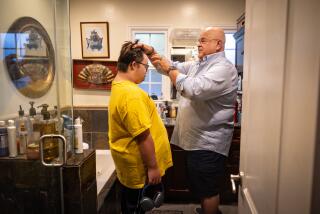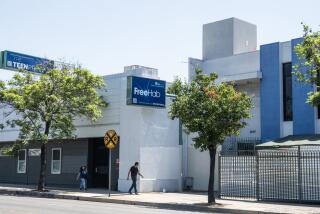Social Service Supermarket : Center Offers Wide Variety of Help for All Ages at 1 Location
- Share via
In this the age of one-stop shopping, giant food markets and multilevel malls, why not have a supermarket of family services, a single place to deal with a range of human problems and needs?
Officials of Family Service of Los Angeles, a nonprofit agency offering counseling and social programs, asked themselves that question as they eyed the abandoned Teen Center on Victory Boulevard in Van Nuys. So did Los Angeles City Councilwoman Joy Picus, who represents the area.
The old Teen Center--two large concrete-block buildings on about 20 acres in the Sepulveda Basin--closed in the early 1980s, a casualty of financial problems, a clouded reputation and the changing tastes of youth.
The property is owned by the Army Corps of Engineers and is leased to the City of Los Angeles. Its 18,000 square feet of office space and extensive open land for recreation made the facility an ideal place to house a variety of programs.
Opened in February
With the FSLA staff writing a proposal to serve as lead agency in the project, and with Picus winning the necessary city approvals, the idea became reality when the Family Service of Los Angeles Community Center officially opened in February.
“The brokering aspect of this project is unique,” explained Geneva Johnson, president and chief executive officer of Family Services of America, an independent organization that reviews and accredits more than 300 agencies nationwide.
“Most of our agencies provide cradle-to-grave services, but they do it themselves,” Johnson said from her Milwaukee headquarters. “What’s different is that FSLA serves as case managers and encourages other agencies to provide services, too.”
Johnson said that the approach eventually should enable the Community Center to offer an unprecedented number of programs at one location. The list of tenants, with such acronyms as LINC, WIC, ACA and CCC, rivals the alphabet soup of the 1930s New Deal.
‘From Birth to Death’
“We’re really trying to develop a community center so families will feel they’ll have a place to come,” said Fran Umansky, director of the facility. “We are not aware of any other multi-agency center trying to include the whole range of services from birth to death.”
Toward that end, she has recruited programs for the very young and the elderly. For example, Women, Infants and Children (WIC) is a federally funded effort providing nutrition education and food vouchers to low-income women who are pregnant or have young children. Living Independently through Networking of Communities (LINC), a project of the Valley Interfaith Council, seeks ways for senior citizens to stay out of nursing homes if they prefer living on their own.
These and other regular tenants pay monthly rent of $1 a square foot to FSLA. Groups such as Adult Children of Alcoholics (ACA), which holds a weekly meeting at the center, pay $25 a session. Umansky said all money collected by FSLA must be spent on improvements and new programs at the center.
An unexpected source of income has been the entertainment industry, she added. Attracted by the center’s huge parking lot, makers of TV shows and commercials have paid $500 to $1,000 a day in location fees to use the center.
A 57-year-old nonsectarian agency with roots in the old Community Chest Planning Council, FSLA offers a wide range of counseling that is billed on a sliding scale. The agency has 10 offices in Los Angeles County and employs 42 people. It receives 60% of its money from the United Way.
FSLA leases the Community Center from the city Recreation and Parks Department for $1 a year and is permitted to use 50% of the office space for its counseling and workshops; the rest is to be used for service agency tenants.
Hopes to Attract Teens
Among other aims, Umansky, 53, hopes to attract programs for teen-agers, the age group most identified with the facility. A 4-H club is planning to start a garden. But nothing is envisioned so far on the scope of the old Teen Center, which thrived from the middle 1950s into the ‘60s, then limped through the ‘70s and early ‘80s.
Umansky, of Tarzana, said that some people still refer to the center by its old name.
“We’re getting away from it, though, because there were a lot of problems--financial problems and drugs and alcohol and vandalism,” she said.
Considerable disagreement exists over the reasons for the Teen Center’s demise. Loeb Aronin, coordinator of psychological services in the Valley for the Los Angeles Unified School District, was president of the Teen Center’s board of directors in 1980 and 1981. He remembers the time as one of constant unexpected financial pressure for the San Fernando Valley Youth Foundation, the citizen group that ran the center.
“Someone said it was like putting a six-foot sheet on an eight-foot bed,” Aronin remembered. “You’d pull here and pull there, but it wouldn’t cover.”
Thefts Hurt Former Center
He said the center was hurt by carnival workers who stole a lot of rented equipment and turned a fund-raiser into a big money loser. Another major setback came when a tenant who was delinquent on rent and other charges skipped out on a $64,000 court judgment.
Aronin also asserted that Picus’ office had a vendetta against the Teen Center and would dispatch police to “harass the kids” without provocation. He charged that the poor reputation accorded the Teen Center was largely undeserved.
But Picus attributed the demise of the Teen Center to bad management.
“Its heyday was the ‘50s and ‘60s,” she said. “As the needs of teens changed, the board failed to see it. They failed to keep up to date.”
Picus conceded, however, that finding ways to serve teen-agers today is a tough question.
Needs Are Unclear
“I don’t know what’s required to meet teen needs,” she said. “There has to be something for kids that’s more than shopping centers and concerts, but I don’t know what that is.”
During the time between the Teen Center’s demise and the entry of FSLA into the picture, Isabelle Walker, chairman of the Department of Recreation and Leisure Studies at California State University, Northridge helped prepare a review of possible center uses.
“Teens have the same needs as before,” she said, “but what they want is different. Hobby clubs aren’t as popular anymore. What might work is off-road vehicle repair programs or an extension of a Sierra Club or a Dodgers booster club.”
Whatever age group a program serves, Walker explained, it must encourage “social and personal development or social adjustment” in order for FSLA to keep its United Way financing.
“What we would not have out there is a program with probation, because that’s rehabilitation, or a driver education program, because that’s schools,” she said.
Library Remains Intact
Betty Miller of Reseda was volunteer director of the Teen Center’s 8,000-volume library, which remains intact. Miller continues to donate time at the center. She remembers dances that drew as many as 1,000 youngsters and said that racial problems in the 1960s caused the numbers to dwindle.
“There were some fist fights and, when the police had to be called, it got on the police blotter and got blown up,” Miller, 68, said, referring to news accounts of the fights. “But it doesn’t take much blowing up to get parents worried about their kids and not allow them to come.”
Although director Umansky does not foresee teen-age dances at the Community Center, she hopes to build a gazebo that can be used for concerts. Plans also call for construction of an after-school playground. Youth soccer teams and miniature off-road car racers already use the center’s outdoor facilities.
Credit Counselors
Umansky said she is negotiating for new programs that include a preschool, youth tutorial projects and classes for illiterate adults. Already in place is Consumer Credit Counselors (CCC), a program that helps persons burdened with credit-card debt.
“We stay busy all the time, unfortunately,” said counselor Ayleen Kodmur.
Of all the Community Center’s tenants, the happiest may be the WIC nutritionists. Mary Lou Thatphithakkul, office director, said that her crew once handled the central Valley part of WIC’s caseload--about 2,000 people--from churches and city parks.
“It was a lot of trouble, putting up the tables and chairs and taking them down again because someone else needed the room. Sometimes we got locked out of a building in winter, but the mothers were there with their babies so we worked out of our cars. Being in this center now is really nice.”
Future Is Uncertain
Despite her high hopes and early successes, Umansky said the Community Center’s future is far from assured.
“We see a real need for this kind of multi-service center,” she said. “Families are so fragmented and even in intact families, with both members working, there’s a need for more education, recreation, and so on. But, whether there is a desire, I don’t know. I don’t know if people will say, ‘I think I’ll take my family down there for counseling, or the workshops, or for recreation.’ ”
Picus expressed more confidence.
“I believe we haven’t begun yet to fully realize its potential,” the councilwoman said. “It’s going to be a gradual evolution over time.”
If, that is, enough time exists. FSLA was given a three-year lease by the city Recreation and Parks Department. Picus said that lease is nearly certain to be renewed, should the center continue to thrive.
The primary lease, however, which the city holds from the Army Corps of Engineers, is more doubtful. Although the lease does not expire until the year 2017, a Corps of Engineers official said it could be terminated.
“They’re not assured of keeping it at all,” said Lewis Trout, specialist in the management and disposal branch of the corps’ real estate division.
Site Could Be Sold
Trout explained that, as part of the Reagan Administration’s effort to sell surplus public land, the General Services Administration has explored the FSLA Community Center site for possible “excessing,” GSA’s term for surplus land sale. The Corps of Engineers, he said, would oppose sale of the land.
“Our position is that it meets the congressional requirement for retention,” Trout said. “The mandate is to use it for flood control and recreation. That particular part of the Sepulveda Basin isn’t really necessary for flood control, but it has a lot of recreational uses.”
Trout predicted that local elected officials and the public would fight a GSA effort to sell the property.
More to Read
Inside the business of entertainment
The Wide Shot brings you news, analysis and insights on everything from streaming wars to production — and what it all means for the future.
You may occasionally receive promotional content from the Los Angeles Times.










